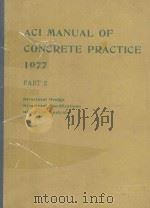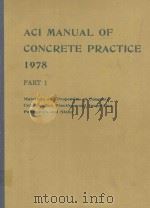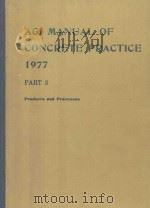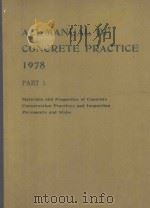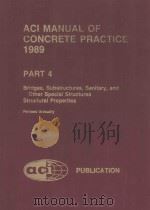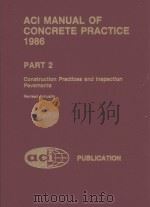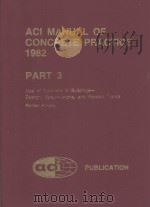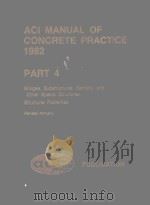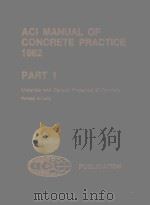《CONCRETE MANUAL A MANUAL FOR THE CONTROL OF CONCRETE CONSTRUCTION SIXTH EDITION》
| 作者 | 编者 |
|---|---|
| 出版 | UNITED STATES GOVERNMENT PRINTING OFFICE |
| 参考页数 | 491 |
| 出版时间 | 1956(求助前请核对) 目录预览 |
| ISBN号 | 无 — 求助条款 |
| PDF编号 | 812504438(仅供预览,未存储实际文件) |
| 求助格式 | 扫描PDF(若分多册发行,每次仅能受理1册) |
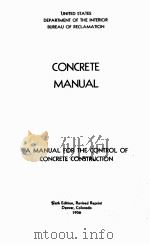
CHAPTER Ⅰ—CONCRETE AND CONCRETE MATERIALS1
A.INTRODUCTION1
1.Concrete defined1
2.Progress in concrete1
3.Making good concrete2
B.IMPORTANT PROPERTIES OF CONCRETE3
4.General comments3
5.Workability7
6.Durability7
(a) Weathering resistance7
(b) Resistance to chemical deterioration8
(c) Resistance to erosion12
7.Watertightness14
8.Volume change15
9.Strength18
10.Elasticity22
11.Creep and extensibility24
(a) Creep25
(b) Extensibility28
12.Thermal properties29
13.Weight30
C.EFFECTS OF VARIOUS FACTORS ON THE PROPERTIES OF CONCRETE30
14.Entrained air content, cement content, and watercontent30
(a) Effects on workability31
(b) Effects on durability31
(c) Effects on permeability33
(d) Effects on volume change33
(e) Effects on strength35
(f) Effects on elasticity37
(g) Effects on creep and extensibility37
(h) Effects on thermal properties37
(i) Effects on unit weight37
15.Composition and fineness of portland cement38
(a) Compound composition of cement38
(b) Types of cement41
(c) Fineness of cement45
16.False set in cement47
17.Use of pozzolans47
18.Quality and gradation of aggregates49
(a) Contaminating substances50
(b) Soundness51
(c) Strength and resistance to abrasion52
(d) Volume change52
(e) Particle shape53
(f) Specific gravity53
(g) Gradation53
19.Quality of mixing and curing water63
20.Use of admixtures64
(a) Accelerators64
(b) Airentraining agents66
21.Field control67
22.Control of heat generation and cracking in concrete69
CHAPTERⅡ—INVESTIGATION AND SELECTION OF CONCRETE MATERIALS75
A.PROSPECTINGFOR AGGREGATE MATERIALS75
23.General comments75
24.Geological and related characteristics of aggregates and aggregate deposits75
(a) Types of deposits75
(b) Classification and characteristics of rocks77
(c) Chemical suitability of aggregates83
25.Prospecting85
26.Preliminary sampling of prospective aggregate sources and reporting of related information86
(a) Sand and gravel deposits87
(b) Prospective rock quarries88
B.EXPLORATION OF NATURAL AGGREGATE DEPOSITS89
27.General procedure89
28.Steelcased test holes89
29.Exploratory excavations92
(a) Test pits92
(b) Trenches100
30.Designation of deposits and of test holes and testpits101
31.Reports and samples required101
C.FACILITIES FOR MATERIALS TESTING ATDENVER103
32.Laboratory facilities103
D.DENVERTESTS AND SELECTION OF AGGREGATES103
33.Tests of aggregates103
34.Analysis of field and laboratory data106
35.Quantity of aggregate107
36.The selected aggregate112
E.PROSPECTING FOR POZZOLANIC MATERIALS113
37.Classification of pozzolans113
38.Geologic occurrences of pozzolan114
39.Samples and information required114
F.DENVER TESTS AND INVESTIGATION OF POZZOLANIC MATERIALS114
40.Tests and analyses of pozzolanic materials114
G.DENVERINVESTIGATIONS OF OTHER MATERIALS115
41.Cement investigations115
42.Investigations of admixtures and sealing com-pounds116
43.Sampling and analysis of water and soil116
CNAPTER Ⅲ—CONCRETE MIXES117
44.General comments117
45.Selection of proportions118
46.Estimate of water requirements118
47.Estimate of cement requirements120
48.Estimate of aggregate requirements123
49.Computations of proportions125
(a) Example 1125
(b) Example 2126
50.Batch weights for field use127
51.Adjustment of trial mix128
52.Concrete mix tests130
53.Mixes for small jobs132
CHAPTERⅣ—INSPECTION, FIELD LABORATORY FACILITIES, AND REPORTS135
A.INSPECTION135
54.Concrete control135
55.Administrative instructions135
56.The inspector135
57.The inspection supervisor135
58.Daily inspection reports136
B.FIELD LABORATORY FACILITIES136
59.The field laboratory136
60.Lists of laboratory equipment142
61.Facilities for curing concrete test specimens145
(a) Water tanks145
(b) Storage in moist sand147
(c) Fogroons147
C.REPORTS AND EVALUATION OF TEST DATA149
62.Reports149
(a) Narrative portion150
(b) Summarized tabulations151
63.Evaluation of test data156
CHAPTER Ⅴ—CONCRETE MANUFACTURING A MATERIALS163
64.Aggregateproduction and control163
65.Sand production163
66.Wet processing of sand166
(a) Spiral classifiers166
(b) Reciprocating rake classifiers168
(c) Hydraulic classifiers169
(d) Hydraulic sizers170
(e) Wet process screens171
(f) Washer and dewaterer173
67.Dry processing of sand173
68.Production and handling of coarse aggregate174
69.Screen analyses180
70.Deleterious substances in aggregate182
71.Control of surface moisture in aggregate183
72.Specific gravity184
73.Miscellaneous tests of aggregate184
74.Aggregate purchased184
75.Cement184
76.Water187
77.Admixtures187
B.BATCHING AND CONTROL FACILITIES FOR LARGE CONCRETE JOBS188
78.Weight vs.volume batching188
79.Batching equipment188
80.Checking scales193
81.Graphic recorders194
C.BATCHING METHODS AND FACILITIES FOR THE AVERAGE JOB199
82.Central batching by weight199
83.Weighing equipment203
84.Batching of liquids207
D.MIXING212
85.General212
86.Truck mixers and agitators214
E.QUALITY CONTROL OF CONCRETE217
87.General217
88.Consistency219
89.Slump222
90.Compressive strength223
91.Air content and unit weight224
F.HOT AND COLD WEATHER PRECAUTIONS IN CONCRETE PRODUCTION225
92.Hot weather precautions225
93.Cold weather precautions226
CHAPTER Ⅵ—HANDLING, PLACING, FINISHING, AND CURING231
A.PREPARATIONS FOR PLACING231
94.Foundations231
(a) Rock231
(b) Earth231
(c) Porous underdrains231
95.Construction joints232
96.Forms240
97.Marking dates on concrete work246
98.Reinforcement steel and embedded parts246
99.Final inspection249
100.Contractor's preparations249
B.TRANSPORTING250
101.Plant layout and methods250
102.Transporting250
(a) Buckets250
(b) Cars and trucks253
(c) Chutes253
(d) Belt conveyors255
(e) Pneumatic methods255
(f) Pumping256
C.PLACING259
103.The mortar layer259
104.General discussion of concrete placement259
105.Mass concrete268
106.Tunnel lining272
(a) Preparation for lining272
(b) Control of seeping or dripping water273
(c) Concrete for tunnel lining273
(d) Placing concrete in tunnel lining274
107.Monolithic siphons277
108.Canal lining280
(a) The concrete mix280
(b) Reinforcement281
(c) Placing the lining282
(d) Contraction joints291
109.Precast concrete pipe294
(a) General294
(b) Cast pipe295
(c) Centrifugally spun pipe297
(d) Tamped and packerhead pipe298
110.Vibrators301
111.Surface imperfections303
112.Bond with reinforcement and embedded parts305
113.Waste concrete305
114.Shutting down concreting operations306
115.Placing concrete in water306
D.REMOVAL OF FORMS, AND FINISHING307
116.Removal of forms307
117.Repair of concrete308
118.Types and treatments of formed surfaces309
(a) Finish F1310
(b) Finish F2310
(c) Finish F3310
(d) Finish F4311
(e) Finish F5311
(f) Special stoned finishes311
(g) Sackrubbed finish312
(h) Sandblast finish312
(i) Vacuumprocessed finish313
(j) Removing stains from formed surfaces313
119.Finishing unformed surfaces313
(a) Finish U1314
(b) Finish U2314
(c) Finish U3315
(d) Finish U4315
(e) Preventing hair cracks315
120.Painting and dampproofing of concrete316
(a) Painting316
(b) Dampproofing316
E.CURING316
121.Moist curing316
122.Curing with sealing compounds318
123.Steam curing321
F.CONCRETING UNDER SEVERE WEATHER CONDITIONS322
124.Precautions to be observed during hot weather322
125.Precautions to be observed during cold weather324
CHAPTER Ⅶ—REPAIR AND MAINTENANCE OF CONCRETE333
126.General requirements for workmanship333
127.Methods of repair334
(a) Repair of new work334
(b) Repair of old work334
128.Preparation of concrete for repair335
(a) Dry pack339
(b) Concrete replacement339
(c) Mortar replacement340
129.Use of drypack mortar340
130.Procedure for replacement of formed concrete342
131.Procedure for replacement of unformed concrete346
132.Procedure for mortar replacement346
133.Repairs undel seepage conditions349
134.Curing of repairs349
135.Treatment for protection of concrete against weath-ering349
(a) General discussion349
(b) Preparation of surfaces350
(c) Treatment of surfaces350
136.Procedure for repair of transverse cracks in con-cretesiphons351
137.Procedure for repair of precast concrete pipe353
(a) General353
(b) Methods of repair354
(c) Preparation of imperfections for repair355
(d) Handplaced mortar replacement356
(e) Pneumatically applied mortar replacement356
(f) Concrete replacement357
(g) Curing of repairs357
(h) Testing repaired pipe358
CHAPTER Ⅷ—SPECIAL TYPES OF CONCRETE ANDMORTAR359
A.LIGHTWEIGHT CONCRETE359
138.Definition and uses359
139.Types of lightweight aggregate359
(a)Cinders359
(b) Expanded slag360
(c) Expanded shale and clay360
(d) Natural aggregate360
140.Properties of lightweight aggregates361
141.Construction control of lightweight concrete362
B.NAILING CONCRETE363
142.Definition, use, and types363
143.Sawdust concrete363
144.Types and grading of sawdust363
C.PREPACKED CONCRETE364
145.Definition and use364
146.Properties of prepacked concrete364
147.Mortar materials and consistency365
148.Coarse aggregate365
149.Construction procedures366
D.PRESTRESSED CONCRETE366
150.Definition and use366
E.VACUUMPROCESSED CONCRETE367
151.Definition, characteristics, and uses367
152.Vacuum forms and panels369
153.Processing procedure370
F.CONCRETE FLOOR FINISH371
154.Requirements for a satisfactory finish371
155.Aggregate373
156.Proportioning and mixing373
157.Preparation of the base374
158.Screeds375
159.Depositing, compacting, and screeding375
160.Finishing376
(a) Floating376
(b) Troweling376
(c) Grinding377
161.Protection and curing377
162.Liquid hardener treatments378
163.Nonslip finish378
164.Colored finish378
165.Terrazzo finish380
G.PNEUMATICALLY APPLIED MORTAR380
166.Definition and use380
167.Preparation of surfaces to be treated381
168.Sand381
169.Rebound381
170.The optimum mix382
171.Mixing382
172.Equipment382
173.Placing and curing383
H.GROUTING MORTAR386
174.Uses and essential properties386
175.Types of nonsettling mortars387
(a) Prolonged or delayed mixing387
(b) Addition of aluminum powder388
(c) Use of special cement388
APPENDIX391
1Sampling aggregate and preparing aggregate sam ples for test391
2 Sampling concrete393
3 Sampling soil and water for chemical analyses401
4 Screen analysis of sand402
5 Screen analysis of coarse aggregate405
6 Screen analysis of combined sand and coarse aggre-gate (computed)405
7 Petrographic examination of aggregates405
8 False set in cement409
9 Specific gravity and absorption of sand411
10 Specific gravity and absorption of coarse aggregate414
11 Surface moisture of aggregate (also specific gravity and absorption)415
12 Unit weight of aggregate for concrete419
13 Clay lumps in aggregate421
14 Organic impurities in sand422
15 Sedimentation test for approximate quantity of clay and silt in sand423
16 Percentage of aggregate passing No200 screen424
17 Percentage of lightweight material in sand425
18 Percentage of lightweight material in coarse aggre gate427
19 Soundness of aggregate (sodiumsulfate method)428
20 Mortarmaking properties of fine aggregate432
21 Abrasion of coarse aggregate by use of the Los Angeles machine434
22 Slump436
23 Unit weight and volume of fresh concrete; and cement, water, air, and aggregate contents of fresh concrete438
24 Air content of fresh concrete by pressure methods442
25 Method of test for bleeding of concrete445
26 Variability of constituents in concrete (a test of mixer performance)447
27 Batching for machinemixed laboratory concrete451
28 Laboratory concrete mixing453
29 Casting cylinders in castiron molds454
30 Casting cylinders in cans456
31 Fieldlaboratory curing, packing, and shipping of test cylinders457
32 Capping concrete cylinders458
33 Compressive strength460
34 Turbidity with Jackson turbidimeter462
35 Temperature of concrete464
36 Sampling airentraining agents465
37 Testingmachine maintenance465
38 Sampling sealing compounds for curing concrete471
39 Sampling mastic joint filler473
40 Cement reference samples473
1956《CONCRETE MANUAL A MANUAL FOR THE CONTROL OF CONCRETE CONSTRUCTION SIXTH EDITION》由于是年代较久的资料都绝版了,几乎不可能购买到实物。如果大家为了学习确实需要,可向博主求助其电子版PDF文件(由 1956 UNITED STATES GOVERNMENT PRINTING OFFICE 出版的版本) 。对合法合规的求助,我会当即受理并将下载地址发送给你。
高度相关资料
-

- ACI MANUAL OF CONCRETE PRACTICE PART 3-1972
- 1972 AMERICAN CONCRETE INSTITUTE
-

- THE CANTILEVER CONSTRUCTION OF PRESTRESSED CONCRETE BRIDGES
- JOHN WILEY AND SONS
-
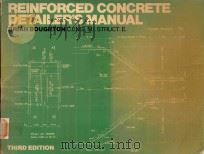
- REINFORCED CONCRETE DETAILER'S MANUAL THIRD EDITION
- 1969 GRANADA PUBLISHING
-
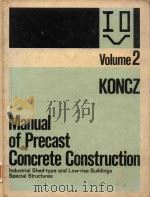
- MANUAL OF PRECAST CONCRETE CONSTRUCTION VOLUME II
- 1971 BAUVERLAG GMBH
-
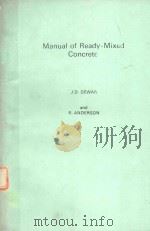
- MANUAL OF READY-MIXED CONCRETE
- 1988 BLACKIE GLASGOW AND LONDON
-
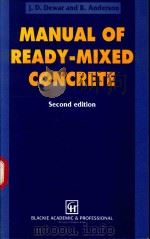
- MANUAL OF READY-MIXED CONCRETE
- 1992 BLACKIE ACADEMIC AND PROFESSIONAL
提示:百度云已更名为百度网盘(百度盘),天翼云盘、微盘下载地址……暂未提供。➥ PDF文字可复制化或转WORD
